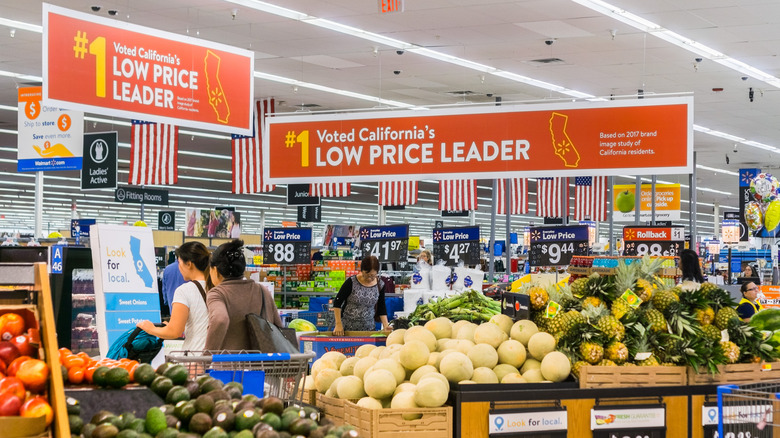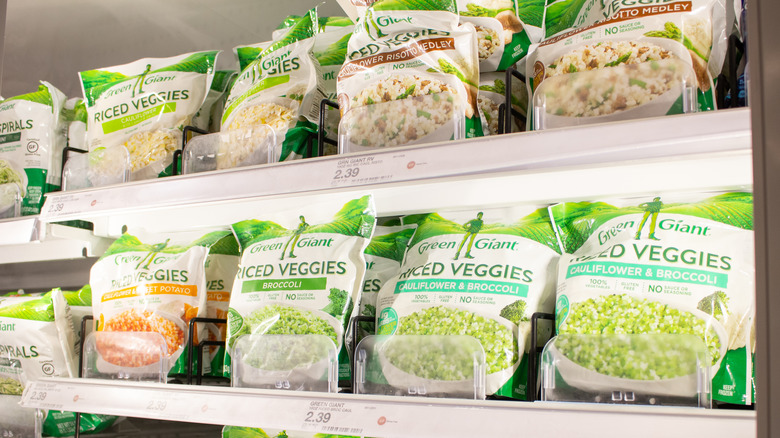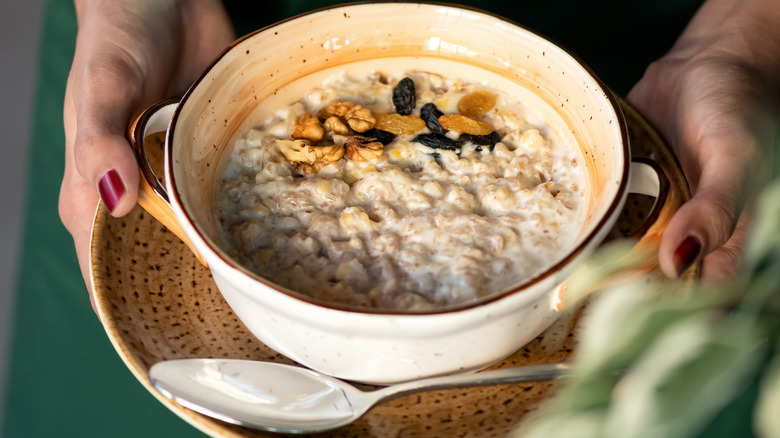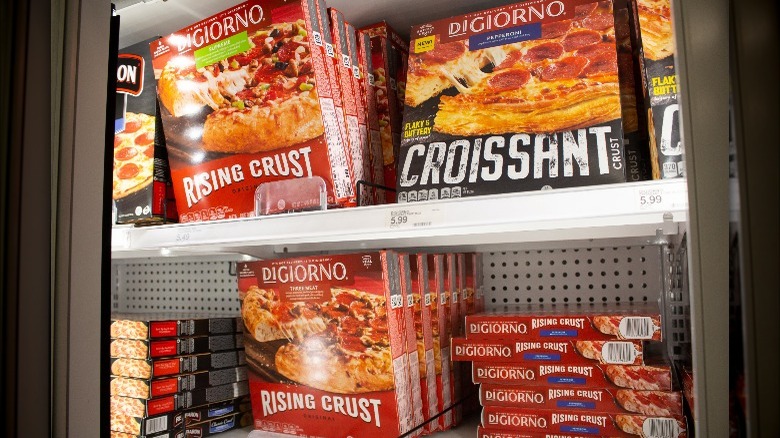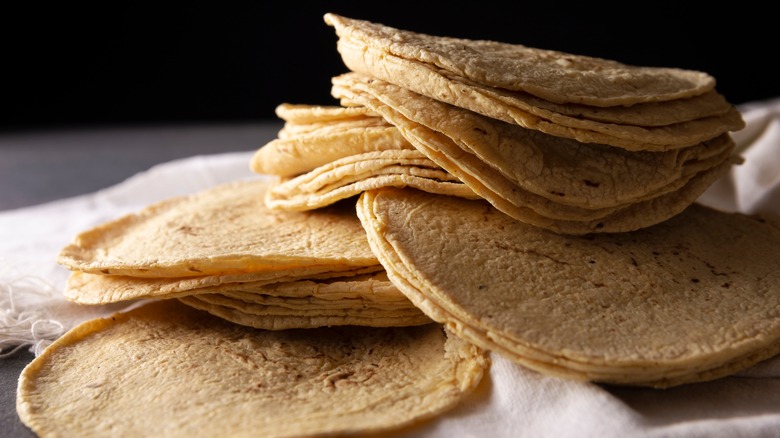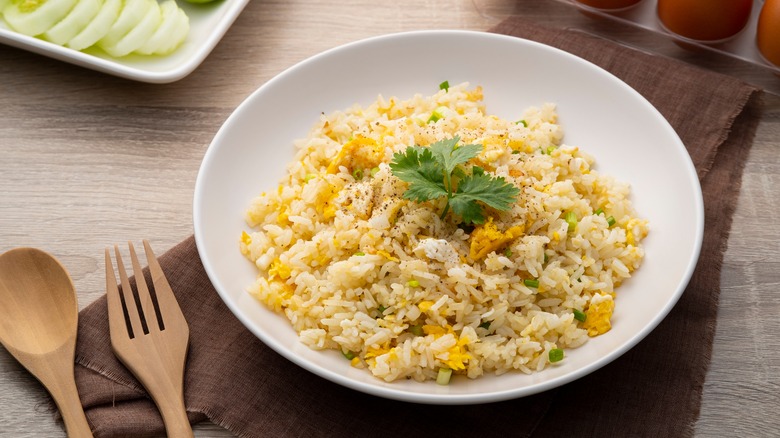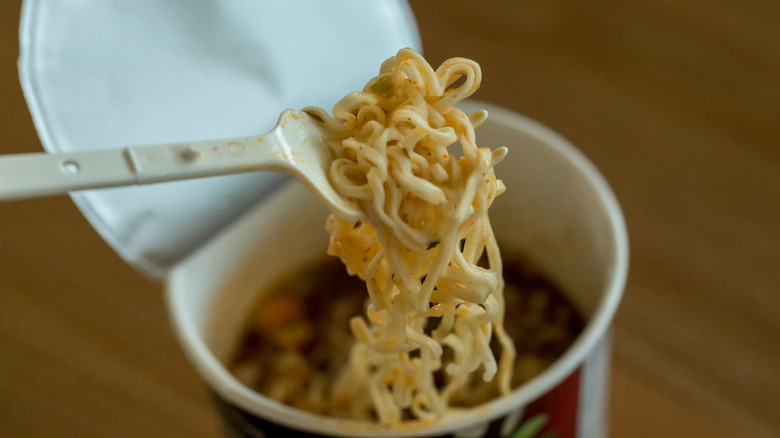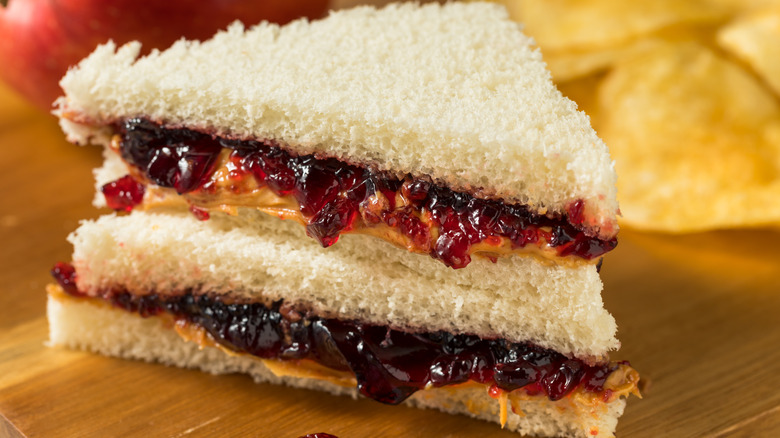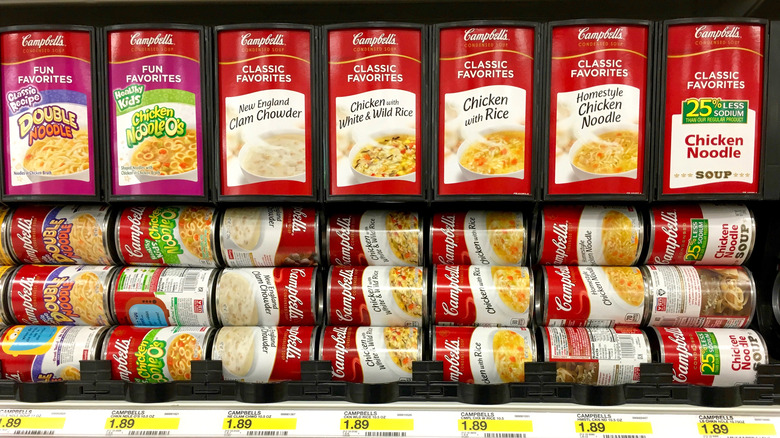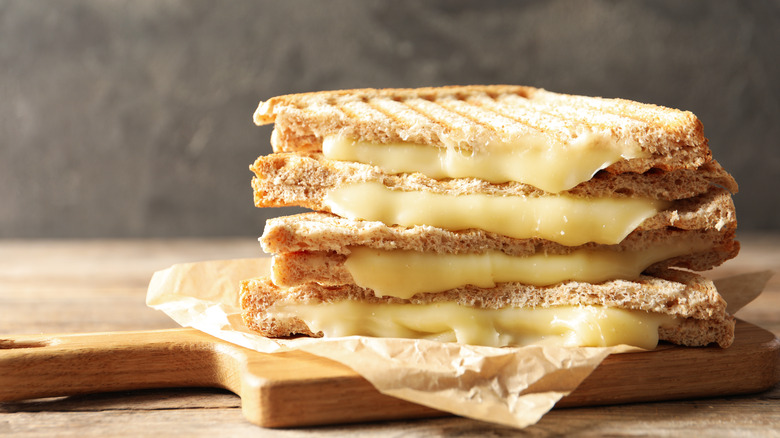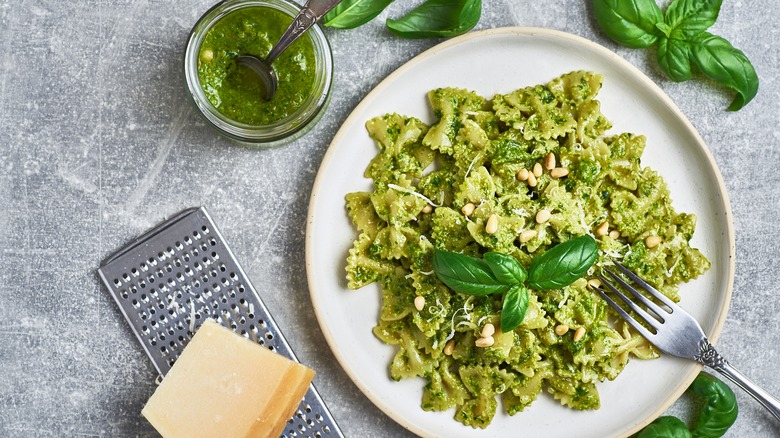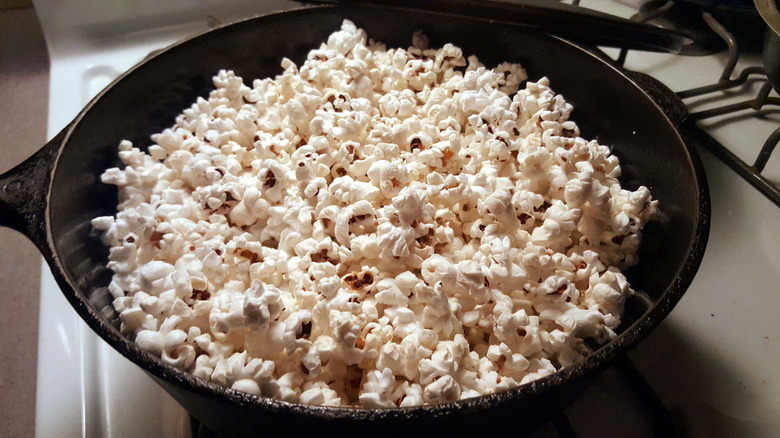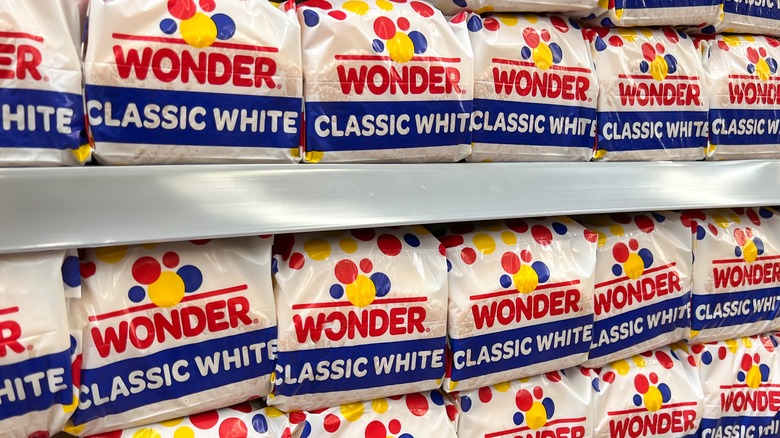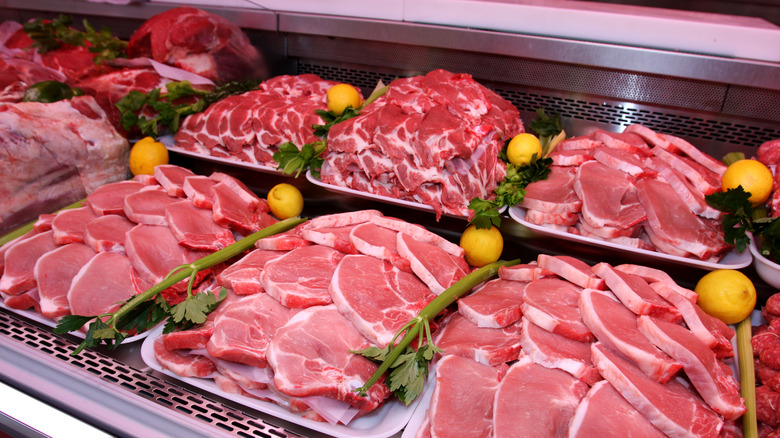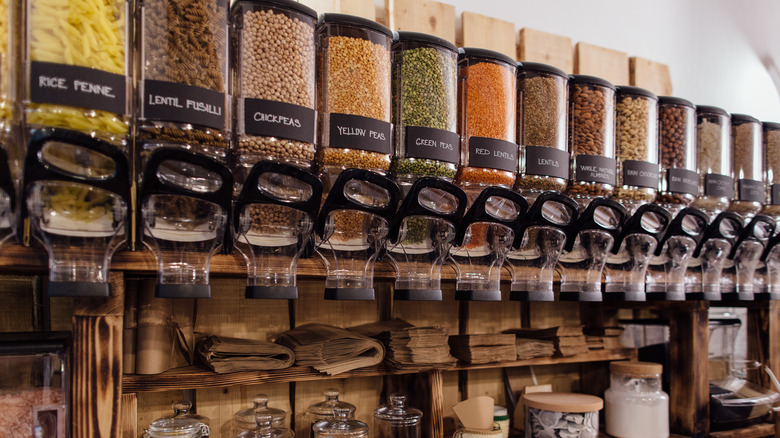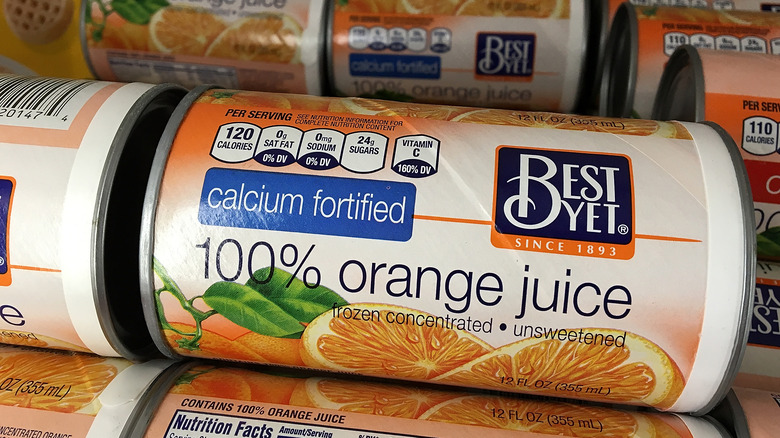Cheap Foods You Should And Shouldn't Buy
Cheap food tends to get a bad rap in the United States. Images of discount store potato chips, sugar-packed cans of soda, and crumbled up fast food wrappers come to mind when thinking about food from a low price point. It is true that the food landscape of the U.S. is incredibly hard to navigate mindfully, healthfully, and frugally. There are, simply put, a lot of cheap food options out there, but not as many that will meet daily nutritional needs. The American Institute for Economic Research points to the rise of the fast food industry, the dominance of corporate farms, and problems with subsidized farming in the United States as root causes for this.
However, the Department of Agriculture warns that these inexpensive, unhealthy alternatives — including many frozen foods and processed snacks at the grocery store — aren't really as cheap as they may first appear. A study from the department discovered that a lot of lower-priced healthy foods beat out low-nutrient alternatives both nutritionally and in a price comparison. Although it can be difficult to weed through all the options, it is possible to eat better on a budget. We're here to get you started with 16 cheap foods that you should and shouldn't buy.
Good: frozen produce
Frozen produce has long suffered under the stigma of being an unhealthier option compared to fresh produce. This is, however, a very inaccurate judgement. While it is true that frozen produce may lose some nutrients when packaged, this is also the case when cooking fresh fruits and vegetables. In fact, studies reportedly show that when packaged properly and under the right conditions, the nutritional value of frozen produce can be just as high, if not higher, than fresh produce (via The Daily Californian). The Eat Right Organization also really sings the praises of frozen produce specifically. According to the organization, the produce is often picked at peak ripeness and then immediately flash frozen, which not only preserves the flavor, but also all of the nutrients.
Of course, a major advantage to frozen produce over fresh is the significantly lower price point. But there are even more benefits to buying frozen produce. When stored correctly, the fruits and vegetables tend to last a lot longer than their fresh counterparts, which means less money wasted on spoiled produce, and eating more berries and greens at their peak performance. One thing to note — make sure to always check the nutrition label, as some frozen fruits and vegetables contain added sugars, salt, or even sauces that counteract their otherwise healthful properties (via The Eat Right Organization).
Good: oatmeal
Oh, sweet oatmeal — pioneer food, breakfast staple, and simple comfort dish. While oatmeal may be a no-thrills meal option, it's a sturdy choice that's sure to have your back on whatever budget. Although oatmeal might be well situated in the American culinary landscape, it actually traces its roots back to China, and was first popularized in ancient Greece (via Wonderopolis). Oatmeal can be served hot or cold, with milled, steel cut, or rolled oats. Water or milk can both be used to whip up a nice bowl of oatmeal, and from there, the topping possibilities, both sweet and savory, are pretty much endless. In other words, there are a lot of ways to make a bowl of oatmeal.
Time credits oatmeal's popularity throughout history and around the world to the dish's insanely low price point and its health benefits. Oatmeal in any form makes for a well-balanced meal. That's because oatmeal is whole grain, which is gluten-free, potentially anti-inflammatory, and very filling. Really, the only challenge with oatmeal is in keeping it healthy by not piling too much sugar and unhealthy toppings when adding much needed flavor to the otherwise bland dish.
Bad: frozen pizza
Frozen pizza may beckon seductively from the freezer aisle, but you should try to resist the urge as much as you can. They never look as good as the picture on the box, are often mushy, and burn easily. Like most frozen foods, frozen pizza was made for convenience. Originally concocted in the period following World War II, the frozen pizza was perfected to provide an easy meal for a busy society and has since grown to warrant its own section in the grocery store (via Medium).
But contemporary frozen pizza is something to be wary of. The price and convenience may not outweigh the health risks. Frozen pizzas are more often than not calorie dense with little nutritional value. They are also routinely packed with too much salt (via Healthline). High sodium content is something to be wary of, as too much salt can contribute to high blood pressure, heart disease, and a range of other health complications, according to the American Heart Association.
Good: corn tortillas
Corn tortillas are cheap, flavorful, and though they may not seem like it, have all the potential to hit the spot with the right filling. Tortillas have long been a staple in Latin American cuisine, tracing back to 10,000 B.C. in contemporary Mexico (via Buffalo Market). The source says that corn tortillas were originally intended to be a modest gift for the king from a peasant. How fortuitous, given that corn tortillas wound up being a gift to the world. Later flour tortillas were developed, but corn tortillas remain the tasty OG.
But, these little numbers aren't just colorful and tasty. According to Uno Casa, corn tortillas are also full of nutrients. Corn tortillas are whole grain and filled with vitamins and minerals, including potassium, magnesium, and more. It's also worth noting that corn tortillas are often less processed than flour ones.
Corn tortillas are definitely not a meal on their own, but when paired with the other mega-cheap and mega-healthy ingredients — like black beans, perhaps — then you've got yourself a quick, easy, and healthy dish that can be made on a dime.
Good: egg fried rice
Egg fried rice is a perfect holdover for college students and frugal shoppers alike. There's a grand tradition of egg fried rice and budget eating. In fact, egg fried rice might just be the direct result of frugal eating! As the story goes, the dish was first stirred up in China as a means of using up leftover rice (via Eating China). Since then, it has traversed cultures and countries and made its way to the United States. As it popularized, it also became more common to add another cheap and nutritional goodie (and one that fries up well in a skillet) to fried rice — eggs.
Really the magnificence of egg fried rice still lays in the spirit of using leftovers. Freshly prepared rice is most likely to get mushy when used; it's day-old rice that holds up the integrity and structure of this dish (via Eating Expired). Paired with a simple egg, and it is truly an economical decision. Egg fried rice will never cost more than a few bucks to make. Not to mention, the combination of rice and egg makes for a protein-rich and filling meal. You can also make this dish even healthier by limiting how much oil you use and maybe mixing in a few vegetables.
Bad: instant ramen
Cheap eating and instant ramen simply go hand in hand; long has a boiling pot of instant noodles been the crown jewel in a low-budget diet. It's hard not to love these flavorful noodles. They're dirt cheap and have a seemingly endless spectrum of flavors. Instant ramen was first developed in Japan in the 1950s in the aftermath of a world war and nuclear fallout. The noodles quickly grew in popularity as cheap instant noodle recipes were perfected and circulated around, eventually spreading all over the world (via Tokyo Ramen Tours).
However, while instant ramen is prized for its low price point, quick convenience, and craveable flavors, it's nutritional content leaves much to be desired. Instant ramen noodles are often completely deficient in any sort of nutrient, ridden with an ungodly amount of sodium, and full of preservatives. Simply put, the price doesn't justify the real cost. Though convenient and tasty, it's best to look elsewhere for the next budget friendly fixing.
Good: peanut butter and jelly
Not just a playground classic, the peanut butter and jelly sandwich is an American standard that could do well in the grown-up world. While peanuts were once an expensive good of the upper class, World War II, military rations, and hungry soldiers helped popularize and cement the PB&J as an affordable, everyday good (via Taste Atlas). This sandwich is easily one of the more filling options on the list, and certainly financially doable with the three ingredient trifecta.
However, it's less straightforward when it comes to the health value of the peanut butter and jelly sandwich. An article from USA Today surmises that the traditional sammies have a few major health pitfalls. Processed white bread, preservative-laden peanut butter, and sugary jam can do more harm than good — those sorts of PB&Js are more likely to give you a sugar crash than anything else. But elevating the PB&J with a few modifications puts it on track as an economically viable and healthful dish. With a whole grain bread, natural peanut butter, and low sugar jelly, this classic won't just feed — it will nourish.
Good: canned soup
When it comes to cheap foods, canned soup is a middle of the road option that some would say has gotten way too much of a bad rap in recent years. LiveStrong argues that canned soup can be a good once-in-a-while option when ill or in need of a quick fix, but on the regular, it is not the hallmark of an overall well-balanced diet.
Really, the trick lies in picking out the right brand of soup. There are a few different approaches to picking out a more balanced canned soup. LiveStrong advises starting with sodium content. After all, a high sodium intake is linked with many health issues. The site advises shoppers to seek out low-sodium or reduced sodium varieties of canned soup. And to avoid high calorie soups with low nutritional value, opt for broth-based soups instead of cream-based. Furthermore, high-fiber soups are sure to fill and be healthful. Health experts at Today also warn that many canned soups contain a surprising amount of sugar, so make sure to carefully read the label before purchasing. The site also notes that plant-based soups may have an extra nutritional kick in comparison to other soups.
Bad: grilled cheese
Another comfort food classic, the grilled cheese, is two great things: ooey and gooey. Grilled cheese is said to have gotten its start during The Great Depression, where it was served open-faced with shredded American cheese (via Wisconsin Cheese Man). It wasn't until the 1960s that the second piece of bread was added, and with it the modern grilled cheese sandwich was born. With its buttered bread slices and the melted cheese that drips out from between them, this sandwich has a special place in our hearts and our stomachs.
Grilled cheese often begs us to sit down and enjoy, but also begs the question — can it be a healthy indulgence as well? As SFGate ruefully notes, unfortunately not. It's pointing out the obvious to say that bread, butter, and cheese do not a light meal make. Grilled cheese is also nutritionally poor, and usually made with ingredients brimming with preservatives and sugar. The good news is that grilled cheese made at home can be modified with a few slightly healthier, but still yummy, alternatives, like whole wheat bread or low calorie cheese.
Good: pesto
What's more comforting than a big bowl of noodles smothered in an aromatic and vibrant pesto sauce? This darling of cheap foods is so versatile in the kitchen, and can elevate countless different dishes and ingredients. There's not one set of ingredients for pesto, which is why it's not uncommon to find a few different colors of pesto in the sauce aisle, and an endless list of possibilities in the kitchen. Pesto can and should always be adjusted by personal taste. Of course, you can't go wrong with the most popular version of pesto, which stars a whole lot of basil, olive oil, and Parmesan cheese.
If you don't have any food intolerances, pesto really checks all the boxes for a filling and nutritional sauce. Sure, it's high in fat, but it's monounsaturated fat. This fat is typical in olive oil, and has been characterized as healthy by the American Heart Association. Depending on the ingredients used for pesto, the sauce can also contain many antioxidants and anti-inflammatory components. As Healthline notes, pesto does fall well into the Mediterranean diet. It's worth noting, as Positive Pause points out, that store-bought pesto sauces tend to have a high sodium content. But there's no need to be intimidated — pesto can be pretty easily recreated at home with simple recipes that leave a lot of room for mistakes, experimentation, and most importantly, enjoyment.
Good: homemade popcorn
The first thought that may come with popcorn is of heaps and heaps of butter and salt, but this snack has a lot of potential to be a cheap and healthy alternative. As WebMD points out, making popcorn at home is the best way to reap all the goodness without any of the damage. By preparing the snack by yourself, it's possible to control the ingredients and thus the ratio of fat and salt going into the snack.
WebMD even claims that popcorn may even have some health benefits. Corn is a whole grain, so technically popcorn can be a whole grain snack that contributes to a lower risk of heart disease, diabetes, and hypertension. According to the American Heart Association, popcorn may be the perfect for adding a nutritional boost to your diet. Popcorn is also a low-density snack, which means a lot can be eaten to meet the calorie budget, leaving the snacker feeling all the more satisfied and full.
Bad: white bread
White bread is an anomaly: as pale as the moon, airy, able to melt on the tongue, and dirt cheap. This delicacy is — surprise, surprise — an American concoction. It was first born in the 1800s out of concern rather than luxury, as food makers had (understandable) concerns surrounding food safety. White bread, an extremely processed food, was first made to provide a bacteria-free bread option (via NPR). It has since become a cornerstone of the American diet and a facet of pop culture. There's a reason it endures: It's affordable, convenient, and the perfect platform for bolder flavors. So what really is the damage when it comes to white bread?
LiveStrong takes a hard stance against white bread. It says that the aforementioned factors just simply aren't enough to make white bread a "good" food healthwise. In fact, the site attributes a whole slew of maladies to the bread: It can lead to excess weight gain, specifically around the belly regions, cause cavities, worsen your mood, and affect the liver negatively. That's certainly a lot of damage from a slice of bread! Is the cheap bread really worth the momentary joy when followed with such a long list of complications?
Good: pork
On the meatier side of American cuisine, pork has historically not been as popular as poultry or beef (via Washington Post). But in post-Recession America, pork has seen an uptick in popularity, namely through fast food and growth in specific Asian food sectors. And there's good reason to think of bringing home the bacon. Pork is often cheaper in comparison to beef (via Your Food Planet).
WebMD dismisses criticisms of pork chops being unhealthy with the mantra "everything in moderation." For budget-oriented diets, pork can be a good and versatile source of protein. As WebMD argues, pork is a really wonderful source of protein, iron, and vitamins B12 and B6. Of course, there are a few things to keep in mind when eating pork. Look for minimally processed and leaner cuts of meat, and be mindful of the high sodium and fat content that slices of pork may have.
Good: lentils
For vegetarians and vegans especially, lentils can be a very important and very affordable source of protein. But, the benefits don't end there. According to One Green Planet, a single cup of lentils contains 36% of daily recommended iron. Lentils not only exist in a wide spectrum of varieties and colors, but they are just as versatile in the kitchen. Lentils can be made into soups, pressed into patties or loaves, sprinkled onto salads, and so much more. And Tasting Table notes that once cooked, lentil water can be saved and repurposed into a broth. That's a lot for a relatively cheap kitchen staple! Lentils are a healthy, economical choice for not just plant-based, but all financially-oriented, eaters.
But there are a few things to keep in mind when making lentils at home. For one, it's advisable to buy lentils in bulk at the grocery store as they tend to be fresher and cook better; packaged lentils inversely sit on grocery shelves a lot longer, so they may be a bit older and take longer to cook. And be sure to always rinse your lentils before cooking them, as they may contain a layer of dust and dirt leftover from being harvested.
Bad: frozen orange juice concentrate
Orange juice may seem like a given at the breakfast table, but that wasn't always the case. Time ties the rise of orange juice, like many other contemporary foods, with the period surrounding World War II. An economic boom in the mid-20th century increased the amount of refrigerators and freezers prolifically across the country. That meant more people around the country could potentially enjoy orange juice. But there was a problem. For some reason orange juice could not be frozen and thawed without tasting like "turpentine." The war helped change that. Scientists trying to figure out how to deliver fighting troops a good supply of palatable vitamin C developed orange juice concentrate, which separated the liquid from the orange. The resulting product could be shipped all over, kept in the freezer, and still tasted fresh when prepared. The rest is history.
Today, orange juice concentrate remains a cheap and refreshing option at the grocery store. But these days, it really is worth it to spring for the fresh stuff, if possible. For one, as noted by LiveStrong, nowadays, juice concentrates come from all over the world. This not only means a heavy carbon footprint, but questionable quality. Research has shown that a considerable amount of popular juice concentrates contain a concerning level of heavy metals. If that wasn't concerning enough, juice concentrate contains all the sugar of juice with none of the beneficial pulp. There are better ways to get a sweet cup of OJ.
